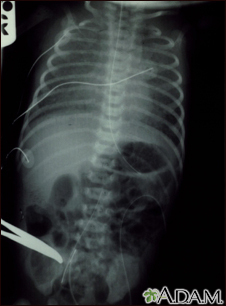Total anomalous pulmonary venous return
Definition
Total anomalous pulmonary venous return (TAPVR) is a heart disease in which the 4 veins that take blood from the lungs to the heart do not attach normally to the left atrium (left upper chamber of the heart). Instead, they attach to another blood vessel or the wrong part of the heart. It is present at birth (congenital heart disease).
Alternative Names
TAPVR; Total veins; Congenital heart defect - TAPVR; Cyanotic heart disease - TAPVR
Causes
The cause of total anomalous pulmonary venous return is unknown.
In normal circulation, blood is sent from the right ventricle to pick up oxygen in the lungs. It then returns through the pulmonary (lung) veins to the left side of the heart, which sends blood out through the aorta and around the body.
In TAPVR, oxygen-rich blood returns from the lungs to the right atrium or to a vein flowing into the right atrium, instead of the left side of heart. In other words, blood simply circles to and from the lungs and never gets out to the body.
For the infant to live, an atrial septal defect (ASD) or patent foramen ovale (passage between the left and right atria) must exist to allow oxygenated blood to flow to the left side of the heart and the rest of the body.
How severe this condition is depends on whether the pulmonary veins are blocked or obstructed as they drain. Obstructed TAPVR causes symptoms early in life and can be deadly very quickly if it is not found and corrected with surgery.
Symptoms
The infant may appear very sick and may have the following symptoms:
- Bluish color of the skin (cyanosis)
- Frequent respiratory infections
- Lethargy
- Poor feeding
- Poor growth
- Rapid breathing
Note: Sometimes, no symptoms may be present in infancy or early childhood.
Exams and Tests
Tests may include:
- Cardiac catheterization can confirm the diagnosis by showing that the blood vessels are abnormally attached
- ECG shows enlargement of the ventricles (ventricular hypertrophy)
- Echocardiogram may show that the pulmonary vessels are attached
- MRI or CT scan of the heart can show the connections between the pulmonary vessels
- X-ray of the chest shows a normal to small heart with fluid in the lungs
Treatment
Surgery to repair the problem is needed as soon as possible. In surgery, the pulmonary veins are connected to the left atrium and the defect between the right and left atrium is closed.
Outlook (Prognosis)
If this condition is not treated, the heart will get larger, leading to heart failure. Repairing the defect early provides excellent results if there is no blockage of the pulmonary veins at the new connection into the heart. Infants who have obstructed veins have worsened survival.
Possible Complications
Complications may include:
- Breathing difficulties
- Heart failure
- Irregular, fast heart rhythms (arrhythmias)
- Lung infections
- Pulmonary hypertension
When to Contact a Medical Professional
This condition may be apparent at the time of birth. However, symptoms may not be present until later.
Call your health care provider if you notice symptoms of TAPVR. Prompt attention is required.
Prevention
There is no known way to prevent TAPVR.
Gallery




References
Valente AM, Dorfman AL, Babu-Narayan SV, Kreiger EV. Congenital heart disease in the adolescent and adult. In: Libby P, Bonow RO, Mann DL, Tomaselli GF, Bhatt DL, Solomon SD, eds. Braunwald's Heart Disease: A Textbook of Cardiovascular Medicine. 12th ed. Philadelphia, PA: Elsevier; 2022:chap 82.
Well A, Fraser CD. Congenital heart disease. In: Townsend CM Jr, Beauchamp RD, Evers BM, Mattox KL, eds. Sabiston Textbook of Surgery: The Biological Basis of Modern Surgical Practice. 21st ed. Philadelphia, PA: Elsevier; 2022:chap 59.
